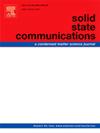基于机器学习方法的全固态电池用高密度Ga-LLZO固体电解质托盘的研制
IF 2.4
4区 物理与天体物理
Q3 PHYSICS, CONDENSED MATTER
引用次数: 0
摘要
氧化物基固体电解质需要高温烧结(>1200°C),以便用于全固态电池,这会导致锂的严重损失。烧结温度较低,致密化程度较低。因此,它的烧结过程涉及许多矛盾,需要大量的试验和错误。本研究使用机器学习(ML)方法解决了这个致密化问题。将掺镓的LLZO(锂镧氧化锆)托盘从室温烧结到1200℃。利用这些烧结过程的数据,使用人工神经网络(ANN)、支持向量机(SVM)和高斯过程回归(GPR)三种ML算法对1000°C和1100°C数据点的ML模型进行训练。对模型进行了高达1200°C的收缩预测精度测试。验证表明,所有ML模型预测收缩的RMSE为<;0.018,有助于致密化改善。1100℃GPR模型精度最高,RMSE为0.0007,优于其他模型。本文章由计算机程序翻译,如有差异,请以英文原文为准。

Development of highly dense Ga-LLZO solid electrolyte pallet for All-Solid-State Battery using Machine Learning Approach
Oxide-based Solid electrolytes require high-temperature sintering (1200 °C) for preferred densification to be used in All-Solid-State Batteries, which invites severe loss of lithium. While its Lower-temperature sintering results in less densification. Thus, its sintering process involves many contradictions and requires extensive trial and error. This study addresses this densification issue using a machine learning (ML) approach. Gallium-doped LLZO (Lithium Lanthanum Zirconium Oxide) pallets were sintered from room temperature to 1200 °C. Data from these sintering processes were used to train ML models with 1000 °C and 1100 °C datapoint using three ML algorithms: Artificial Neural Network (ANN), Support Vector Machine (SVM), and Gaussian Process Regression (GPR). The models were tested for shrinkage prediction accuracy up to 1200 °C. Validation showed all ML models predicted shrinkage with 0.018 RMSE, aiding densification improvement. The 1100 °C GPR model had the highest accuracy with a 0.0007 RMSE, outperforming other models.
求助全文
通过发布文献求助,成功后即可免费获取论文全文。
去求助
来源期刊

Solid State Communications
物理-物理:凝聚态物理
CiteScore
3.40
自引率
4.80%
发文量
287
审稿时长
51 days
期刊介绍:
Solid State Communications is an international medium for the publication of short communications and original research articles on significant developments in condensed matter science, giving scientists immediate access to important, recently completed work. The journal publishes original experimental and theoretical research on the physical and chemical properties of solids and other condensed systems and also on their preparation. The submission of manuscripts reporting research on the basic physics of materials science and devices, as well as of state-of-the-art microstructures and nanostructures, is encouraged.
A coherent quantitative treatment emphasizing new physics is expected rather than a simple accumulation of experimental data. Consistent with these aims, the short communications should be kept concise and short, usually not longer than six printed pages. The number of figures and tables should also be kept to a minimum. Solid State Communications now also welcomes original research articles without length restrictions.
The Fast-Track section of Solid State Communications is the venue for very rapid publication of short communications on significant developments in condensed matter science. The goal is to offer the broad condensed matter community quick and immediate access to publish recently completed papers in research areas that are rapidly evolving and in which there are developments with great potential impact.
 求助内容:
求助内容: 应助结果提醒方式:
应助结果提醒方式:


